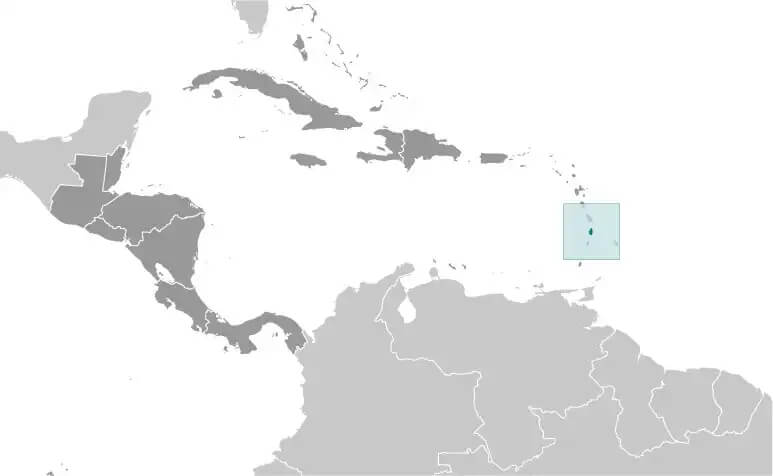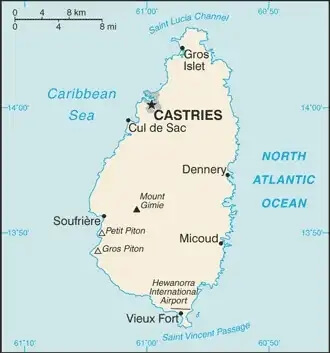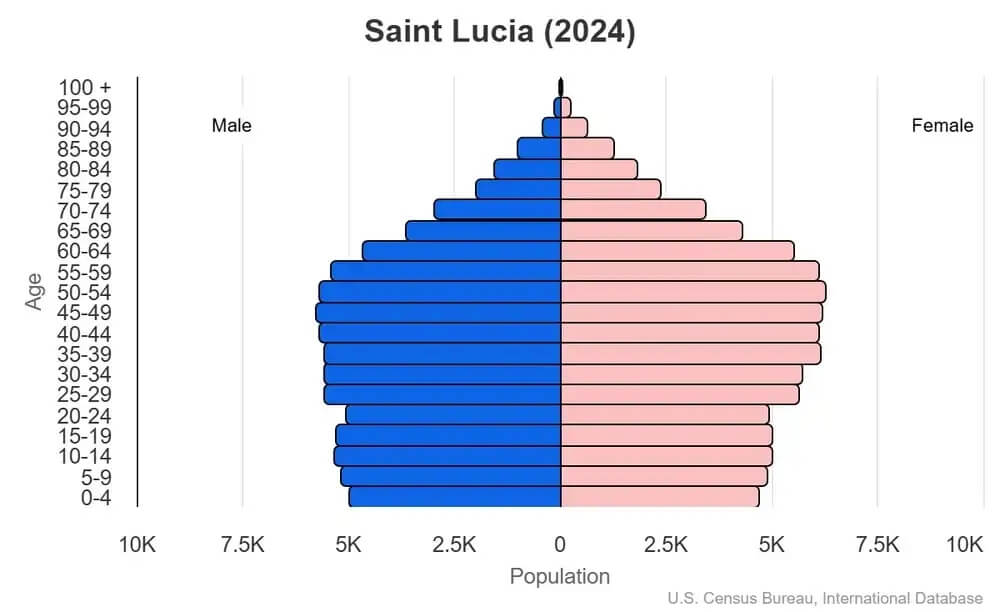World Book
Saint Lucia
Introduction
Background
England and France contested Saint Lucia -- with its fine natural harbor at Castries and burgeoning sugar industry -- throughout the 17th and early 18th centuries, with possession changing 14 times; it was finally ceded to the UK in 1814. Saint Lucia joined the West Indies Federation (1958-1962) and in 1967 became one of the six members of the West Indies Associated States. In 1979, Saint Lucia gained full independence.
Geography
Area
total : 616 sq km
land: 606 sq km
water: 10 sq km
Climate
tropical, moderated by northeast trade winds; dry season January to April, rainy season May to August
Natural resources
forests, sandy beaches, minerals (pumice), mineral springs, geothermal potential
People and Society
Population
total: 168,038 (2024 est.)
Ethnic groups
Black/African descent 85.3%, mixed 10.9%, East Indian 2.2%, other 1.6%, unspecified 0.1% (2010 est.)
Languages
English (official), Saint Lucian Creole
Religions
Roman Catholic 61.5%, Protestant 25.5% (includes Seventh Day Adventist 10.4%, Pentecostal 8.9%, Baptist 2.2%, Anglican 1.6%, Church of God 1.5%, other Protestant 0.9%), other Christian 3.4% (includes Evangelical 2.3% and Jehovah's Witness 1.1%), Rastafarian 1.9%, other 0.4%, none 5.9%, unspecified 1.4% (2010 est.)
Population growth rate
0.26% (2024 est.)
Government
Government type
parliamentary democracy under a constitutional monarchy; a Commonwealth realm
Capital
name: Castries
Executive branch
chief of state: King CHARLES III (since 8 September 2022); represented by Acting Governor General Errol CHARLES (since 11 November 2021)
head of government: Prime Minister Philip J. PIERRE (since 28 July 2021)
Diplomatic representation in the US
chief of mission: Ambassador Elizabeth DARIUS-CLARKE (since 7 June 2022)
Economy
Economic overview
upper middle-income, tourism-based Caribbean island economy; environmentally fragile; energy import-dependent; major banana producer; well-educated labor force; key infrastructure, IT, and communications investments
Real GDP (purchasing power parity)
$4.359 billion (2024 est.)
$4.196 billion (2023 est.)
$4.105 billion (2022 est.)
Real GDP per capita
$24,300 (2024 est.)
$23,400 (2023 est.)
$23,000 (2022 est.)
Exports
$1.6 billion (2024 est.)
$1.419 billion (2023 est.)
$1.29 billion (2022 est.)
Exports - partners
Guyana 20%, Suriname 15%, USA 11%, Barbados 8%, Dominica 7% (2023)
Exports - commodities
refined petroleum, gravel and crushed stone, beer, liquor, paper containers (2023)
Imports
$1.446 billion (2024 est.)
$1.292 billion (2023 est.)
$1.2 billion (2022 est.)
Imports - partners
USA 59%, Guyana 8%, Brazil 7%, China 5%, UK 3% (2023)
Imports - commodities
refined petroleum, crude petroleum, cars, poultry, plastic products (2023)
Human Development Index
The country's Human Development Index (HDI) is 0.748, ranking it 103rd out of 193 countries tested. (more information)



